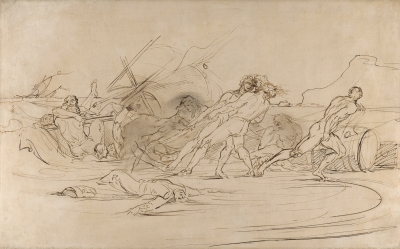Johan Zoffany departed for India in 1783, as Paul Sandby noted, where he ‘anticipates to roll in gold dust.’[1] He was given permission to travel by the East India Company in the capacity of a portrait painter and he must have hoped that his success at the Courts of Europe in the previous decades would be replicated in British controlled Calcutta. Indeed, the roll-call of patrons he did attract on arrival suggests that his financial predictions were correct, shortly after arriving, he produced portraits of: Warren Hastings, Elijah Impey, Claude Martin, and Asaf-ud-Daula. Although he established a successful practice amongst Europeans in Calcutta, his most engaging and important work emanated from the time he spent ‘up-country’.
Zoffany left Calcutta for Lucknow in 1784 where he remained until 1786. Lucknow was the capital of Awadh, outside the territory administered directly by the East Indian Company, although within its sphere of influence. Ruled by the Nawab Vizier of the Mughal Empire, Asaf-ud-daula, it was the home to a cultured and splendid court which included a number of prominent Europeans, including Colonel Claude Martin. Zoffany painted official portraits of Asaf-ud-daula and his chief minister Hasan Reza Khan and undertook his most famous Indian composition in the city: Colonel Mordaunt’s Cock Match. It depicted the court at play, incorporating portraits of the principal courtiers and members of the European diaspora in Awadh, including a self-portrait of Zoffany himself, the painter Ozias Humphry and Claude Martin.
Zoffany returned to Lucknow, preparing for his departure from India in 1787, and stayed with Martin at the house he had built close to the city, known now as Farhad Baksh. As Mary Webster has noted: ‘from this moment he began to penetrate more deeply into Indian life, and to be captivated by its strangeness.’[2] It was on this later trip that Zoffany began to develop an interest in the Indian landscape, producing a number of distinctive drawings in black, red and white chalks on a green-grey paper. The surviving drawings are principally topographical, documenting his return journey from Lucknow to Calcutta down the Ganges. These sheets show the buildings and incidents he witnessed along the river, from the dilapidated buildings on Martin’s estate at Najafgarh (Ashmolean Museum, Oxford), to the death of a Hindu at the ghats of Ghazipur (Yale Center for British Art, New Haven). They are considered some of the most evocative and sensitive landscape drawings made by a European artist in India during the eighteenth century.
The present drawing shows a number of figures gathered on the banks of a body of water, possibly a public washing place. On the left there appears to be a holy man, with long hair holding a jar, a figure type identifiable from other of Zoffany’s landscape drawings, for example A Fakir Standing in a River below an Overhanging Tree and Rock (Courtauld Gallery, London). There appear to be a group of women washing, again this is a type found in other of Zoffany’s landscape drawings for example A Public Washing Place Below a Temple at Kara (private collection). Densely worked in black, red and white chalk, this drawing is an unusually complete statement.
This sheet, along with most of Zoffany’s Indian landscape drawings, were first recorded in the collection of Major R. G. Hutchinson. It seems likely that Hutchinson owned the contents of a single lot from Zoffany’s posthumous sale. The auction of his studio, conducted by ‘Messrs Robins’ in May 1811 contained a considerable number of studies listed as: ‘drawings in chalks, illustrative of the country and manners of India – by Mr Zoffany.’ It is notable that most of the dated drawings made by Zoffany in the late Autumn of 1788 remained together until the 1950s.


